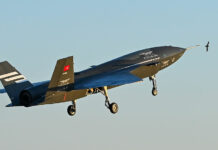High Altitude Long Endurance UAV – Northrop Grumman / USA
Once mission parameters are programmed into Global Hawk, the UAV can autonomously taxi, take off, fly, remain on station capturing imagery, return and land. Ground-based operators monitor UAV health and status, and can change navigation and sensor plans during flight as necessary. The US Air Force intends to acquire a total of 51 Global Hawks between 2006 and 2012. Other countries interested in Global Hawk are Australia, Japan, South Korea and Germany. However, due to missile technology transfer limitations, approval of such sales is questionable.
Global Hawk High Altitude Long Endurance reconnaissance system consists of an Unmanned Aerial Vehicle (UAV), ground segment and communications system providing the US Air Force and joint battlefield commanders with near-real-time, high-resolution, intelligence, surveillance and reconnaissance imagery. In total, the program will cover the production of up to 51 platforms to be operated by the 9th Reconnaissance Wing at Beale AFB, California.
Currently under low rate production are seven aircraft of the RQ-4A Version, also designated “Block 10”. Two more Global Hawks are destined to the US Navy for evaluation of unmanned maritime surveillance missions. Currently undergoing developmental testing, the unit is expected to become operational by early 2006. At that time, production will shift to the more advanced RQ-4B (Block 20). The only Global Hawk flying in support of operations in Afghanistan and Iraq is the Advanced Concept Technology Demonstrator [ACTD]. Although this specific aircraft was designed as a developmental platform, most of its missions are actually devoted to combat. Since the beginning of the flight testing program the ACTD aircraft has accumulated over 6,700 flight hours, over 4,300 of them recorded on 200 combat missions, 40 flown in straight succession without failure. Although accounting for only three percent of the total ISR sorties during the 26-day campaign, Global Hawk provided over half of the time critical targeting data against Iraq’s air defense assets. According to Northrop Grumman, the ACTD demonstrating 95% mission accomplishment rate, far above the performance of other manned or unmanned systems. Two more RQ-4A Block 10 aircraft are scheduled to join the ACTD in the fall of 2005.
By mid 2005 the RQ-4 Block 20 is already in production. The larger airframe (wingspan of 130.9 feet, and 47.6 feet long) is configured with more payload bays and two external pylons. The US Air Force does not plan to use weapons with the Global Hawk. These payloads could therefore be used to carry other systems, such as deployable sensors and expendable mini-drones. In total, the new platform will increase the payload from its current 2,000 pounds (Block 10) to 3,000 pounds. More sensors will be installed, including SIGINT and maritime search radar.
Global Hawk Block 20 which rolled out of Northrop Grumman’s assembly line at Palmdale, Ca. on August 25, 2006 will be fitted with a high-speed network interconnecting all systems on board. A 150% increase in power will be provided by a redundant electrical generator. Another significant change will be the operating system. Unlike Block 10 aircraft, the “B” will use separated flight and sensor management systems. Enhancements are planned for the ground stations, with the introduction of automated collection management and automated contingency with TCDL data links adding direct connectivity with ground forces in theater.
In September 2006 Northrop Grumman Systems Corp. received US$22 million to continue support the operation of the two RQ-4A Global Hawks deployed in forward locations through January 2007. The company also received US$20 million to stock initial spares for RQ-4A and RQ-4B aircraft. Since 2001 and has logged more than 6,500 flight hours during combat missions. Nine RQ-4A aircraft have been produced. The first RQ-4B (Block 20) aircraft was rolled out in August 2006.
New SIGINT Mission Payload Tested
A SIGINT sensor developed for the Global Hawk platform is the High Band System Production Configuration Unit (HBS PCU), designed and produced by Northrop Grumman Corporation. The sensor is designed to detect and identify radar and other types of electronic devices from an altitude of 60,000 feet. HBS PCU is a key subsystem of the Airborne Signals Intelligence Payload (ASIP) sensor which is being developed and is expected to be operationally fielded in 2008.
The Global Hawk’s Airborne Signals Intelligence Payload (ASIP) is expected to increase the signals-collection capabilities of the U.S. armed forces. It will be integrated into the U.S. Air Force’s Distributed Common Ground Stations (DCGS), which are used to analyze electronic intelligence gathered by various airborne systems. Development of the HBS-PCU is scheduled for completion by the end of 2006. (January 10, 2006)
August 2006: Global Hawk UAV achieved 10,000 flight hours in June 2006, of which 63% were flown in combat missions.
















